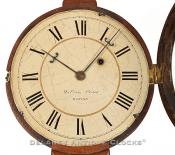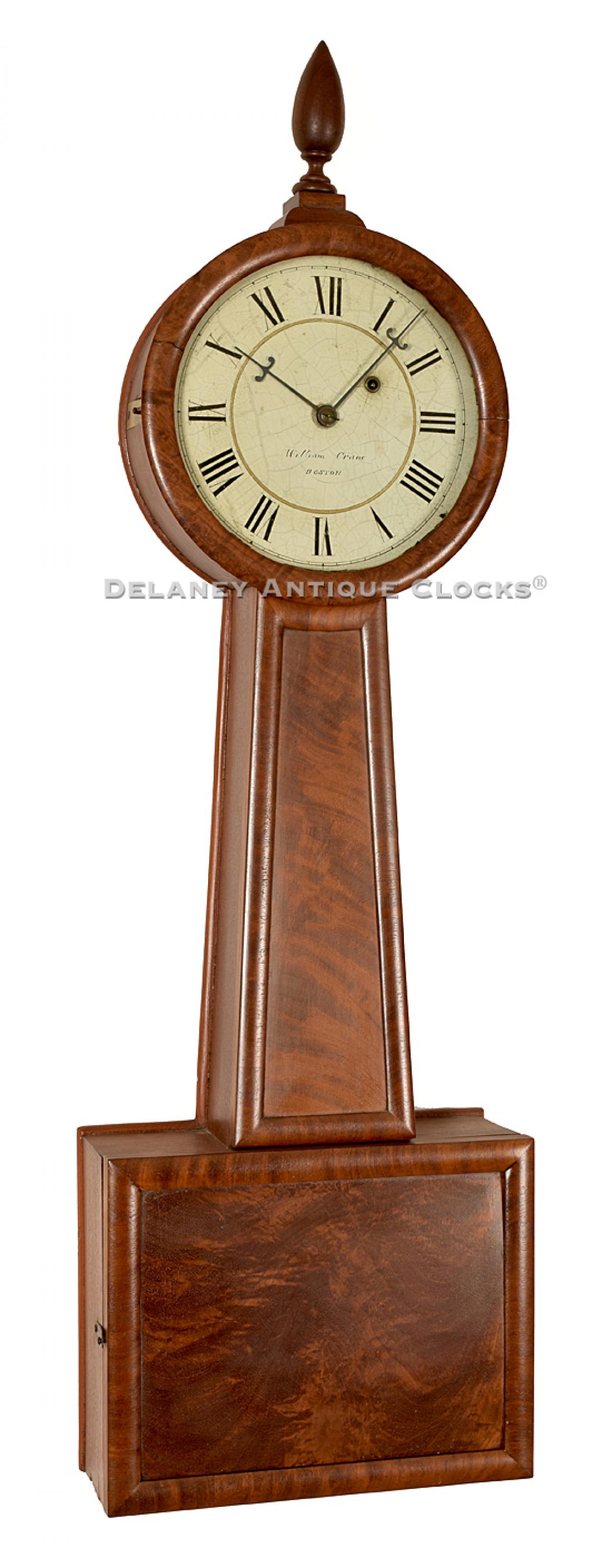William Crane, Boston, Mass. A Fine mahogany cased wall timepiece made circa 1820. 221058.
This handsome timepiece is more commonly called a "Banjo" clock. It is a later version of the form and features a wooden bezel, half-round mahogany frames, and highly figured mahogany veneered wooden panels. The wooden panels were used in place of the more traditional reverse-painted glass tablets that are typically seen in timepiece design. This version became a somewhat popular choice and was made in significant numbers later in the evolution of the timepiece form. This example's clean, sleek design offers a simpler appearance than the standard form, which traditionally is fitted with colorfully painted tablets and brass decorations that include a finial, dial bezel, and sidearms.
This clock was made by William Crane in Boston, Massachusetts, circa 1820. It is currently the only known banjo clock signed by this Clockmaker. It is also interesting to note that it is signed with the working location as "Boston" and not Stoughton or Canton. I speculate that this clock was made for a distant market, perhaps Baltimore or even further south. Crane may have used the city of Boston as his working location because it was so well known throughout the colonies for the source of quality clocks. The towns of Stoughton or Canton would have to be explained to someone not familiar with the region. The construction of the case also supports this theory. The wooden panels and the lack of sidearms would make this clock less susceptible to damage during transport, thus increasing the likelihood of making the journey safely. William Crane was not a prolific clockmaker. We have seen and owned several tall case clocks made by William and his son, Simeon Crane.
The case is constructed in mahogany. The shellac finish enhances the vibrant figure exhibited in the wood panels. These veneered panels were carefully selected for their "wow" factor. The half-round mahogany bezel is fitted with glass. The bezel is secured with a push-button latch. At the top of the case is a finely turned wooden finial mounted on a nicely shaped plinth.
The painted iron dial is in excellent original condition. This dial is signed across the center section just below the hand arbor by the Clockmaker. It reads, "William Crane / BOSTON." A decorative gold ring is painted on the inside of the time track. The Roman-style numerals demark the hours. The minute ring is closed. The surface of the dial has developed a wonderful crackleture. The time is indicated by elegantly formed barbed hands.
Behind the dial is a brass movement that is weight-driven and is designed to run for approximately eight days fully wound. The movement is mounted to the back of the case with a single screw. The pendulum features a keystone and a brass-faced bob.
This fine clock has the following dimensions in inches: height 33, width 10, and depth of 3 ¾.
Inventory number 221058.
Clockmaker, watchmaker, gunsmith and brass founder.
William Crane was born in Stoughton, Massachusetts on August 12, 1749 and died there on May 8, 1820. In about 1780, William moved to Canton, MA on Packeen Road now Dedham Street and and worked as a clockmaker, gunsmith and brass founder. He had at least four children. His son Simeon (1774-1821) was also a clockmaker. Two of William's daughters married the clockmaking brothers Henry and Elijah Morse. In 1808, Hannah Crane married Elijah Morse and Lucy Crane married Henry Morse Jr in 1809. The Morse brothers are thought to have apprenticed to Crane. In 1810, William's son Simeon may have been in business with his father in Canton.












